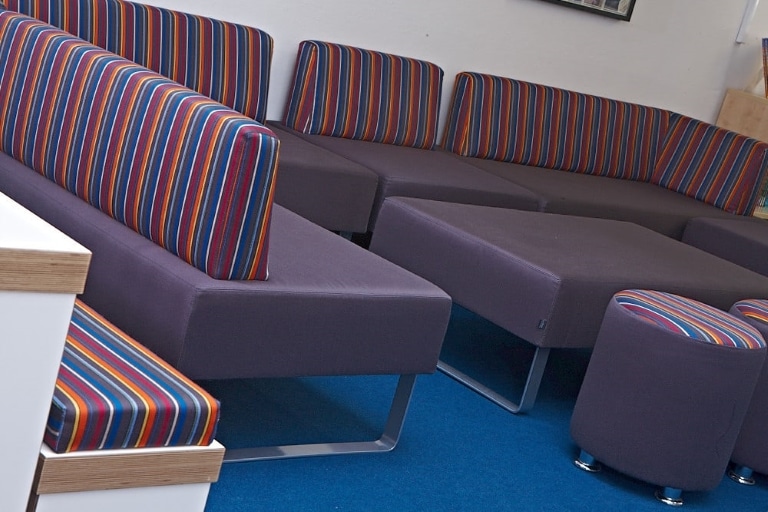How Does Physical Comfort Affect Learning?
Mar 6, 2025 • 4 minutes

Hours spent shifting in hard, plastic chairs, trying to find a better position is a school memory many of us share. Surprisingly, not much has changed. Students spend around 97% of their lesson time sitting, and if their chairs offer little in the way of support, discomfort can quickly become a distraction.
As we begin to understand more about how physical comfort affects focus and learning, is it time to rethink classroom seating?
Why Are School Chairs So Uncomfortable?
When schools choose furniture, practicality comes first. Chairs need to handle daily use by hundreds of students without breaking, so they are often made from hard plastic or metal. These materials are tough, easy to clean and resistant to damage, which are all important factors in busy classrooms where furniture takes a lot of wear and tear. A chair that lasts for years without needing repairs or replacement makes financial sense.
But while they are built to last, they are not always built for comfort. Most school chairs are one-size-fits-all, even though students vary in height, size and how they sit, and the design is often basic and rigid. After a few hours, sitting still becomes harder, and students start shifting, fidgeting and trying to get comfortable. When the focus is on relieving discomfort instead of paying attention, it is easy to see how seating can have an impact on learning.
The Link Between Comfort and Concentration
Better Posture, Better Focus
When students sit in chairs that support the natural curve of the spine, they are able to sit more upright. This keeps their body in a balanced position, reducing strain on the back and shoulders. When seating does not provide this support, students naturally start to slouch or lean forward, which may feel comfortable at first but gradually leads to discomfort and fatigue.
Slouching also restricts lung expansion, making it harder for the body to take in enough oxygen. With less oxygen reaching the brain, alertness and concentration start to dip, making it more difficult for students to stay focused on their work. Over time, poor seating can create a cycle where discomfort leads to fidgeting, loss of attention and reduced participation in lessons.
Reduced Risk of Long-Term Health Issues
Back pain is often thought of as an issue for adults, but studies show that poor posture in childhood can lead to chronic pain later in life. Research by Abertawe Bro Morgannwg University Health Board, Swansea found that 72% of primary school children and 64% of secondary school children reported experiencing back pain at school. Worse still, children who experience back pain early are four times more likely to suffer from it as adults. Providing supportive chairs from a young age helps reduce these risks and encourages healthier sitting habits.
Increased Confidence and Well-Being
Reducing distractions caused by discomfort helps students feel more at ease in the classroom. When a student is not constantly adjusting their position or feeling discomfort, they can listen, and engage with lessons more confidently. Over time, this helps build greater self-assurance and a more positive attitude towards school.
How to Improve Seating in Your School
Having ergonomic seating supports good posture, reduces distractions and helps students stay comfortable throughout the day. But how can you tell if your current classroom chairs are helping or hindering learning?
A well-designed chair should include:
- A contoured seat and backrest. Chairs should support the natural shape of the spine, particularly the lower back. Without proper lumbar lumbar support, students are more likely to slouch.
- The right seat height for the age group. Students should be able to sit with their feet flat on the floor and their knees at a 90-degree angle. If chairs are too high or too low, they force awkward sitting positions that can affect posture over time.
- A slight tilt or flex in the backrest. Completely rigid chairs can become uncomfortable after long periods. A small amount of movement reduces tension and encourages natural shifts in posture.
- A stable, well-balanced base. Chairs should be light enough to move easily but sturdy enough to stay put. If a chair wobbles or tips too easily, students may feel unstable and less engaged.
If your current seating lacks these features, it might be time to rethink your school’s furniture. Investing in high-quality, ergonomic seating is an investment in better learning outcomes.
Transform Your Classrooms with Westcountry Group
At Westcountry Group, we believe that well-designed school furniture is the foundation of effective learning environments. With over 45 years of experience in designing educational spaces, we are dedicated to creating classrooms that inspire, engage and support students of all ages and abilities. Here is what teachers and staff had to say about our work.
Contact Westcountry Group today to discuss how we can help transform your classroom — call 0330 030 0330, email: sales@westcountrygroup.com or visit the education section on our website.






